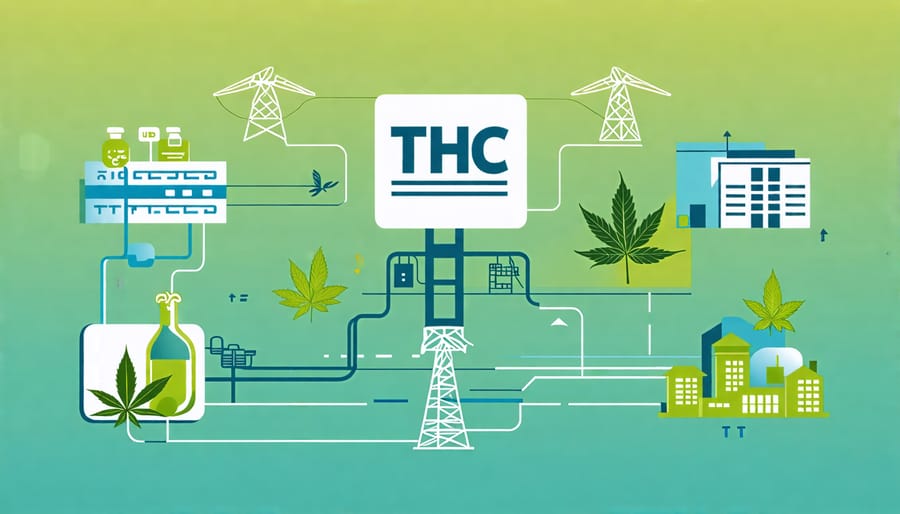The intersection of THC regulations and Canada’s telecommunications industry presents a complex landscape of challenges and opportunities. While consumers might explore products like d8 flower online, the regulatory framework surrounding THC has far-reaching implications for telecom infrastructure, service delivery, and consumer privacy. This analysis examines how cannabis regulations are shaping the telecommunications sector in Canada, from compliance requirements to market opportunities and consumer impacts.
Overview of THC Regulations in Canada
Historical Context
The evolution of THC (tetrahydrocannabinol) regulations in Canada has been a gradual but significant process, directly impacting various industries, including telecommunications. Initially, cannabis prohibition dominated Canadian law; however, public and governmental attitudes shifted over the years, culminating in the Cannabis Act of 2018. This landmark legislation made it legal for adults to possess and use cannabis, significantly impacting market conditions and regulatory landscapes across multiple sectors. For the telecommunications industry, THC regulations have led to increased demand for mobile applications and digital platforms that provide information on cannabis products, usage guidelines, and legal compliance. These changes have prompted telecom companies to adapt by enhancing data services and developing secure apps that cater to cannabis-related content. As regulations continue to evolve, telecom operators must navigate legal requirements while addressing consumer demand for cannabis-related digital services. Understanding these shifts is crucial for consumers and industry professionals to make informed decisions in a dynamic regulatory environment.

Current Legal Framework
In Canada, the current legal framework surrounding THC flower is regulated under the Cannabis Act, which was enacted in 2018. This legislation allows for the sale and consumption of THC flower, subject to strict federal and provincial regulations. Each province may impose additional guidelines, including restrictions on sale locations and consumption areas. It’s essential for consumers and businesses to adhere to these rules, as non-compliance can lead to significant penalties. While the Cannabis Act provides a broad framework, the specific regulations can vary across different regions in Canada, affecting consumer access and market dynamics. For telecom companies, understanding these variances is crucial, as the legal status impacts market strategies and customer service models. Companies in this sector may face unique challenges, such as handling increased data traffic from cannabis-related apps and ensuring compliance with privacy standards in communications. Overall, staying informed about THC regulations is vital for both telecom professionals and consumers as they navigate this evolving landscape.
Impact on the Telecommunications Industry

Regulatory Compliance
Telecom companies in Canada face significant challenges in navigating regulatory compliance related to THC, particularly considering the complexities introduced by cannabis legalization. These challenges primarily revolve around adherence to consumer privacy laws and maintaining service reliability amid increasing demand for secure, privacy-centric communication platforms. Telecom firms must ensure their networks and data management practices comply with strict privacy standards, as outlined by the Personal Information Protection and Electronic Documents Act (PIPEDA), while also accommodating the lawful usage of cannabis-related content and transactions over their networks. Additionally, companies need to proactively address potential interference with sensitive equipment and network integrity, posed by the operations of cannabis producers, who often utilize advanced remote monitoring systems. Ensuring seamless service while adhering to these complex regulations requires telecom operators to invest in technological infrastructure and regularly update compliance protocols, underscoring the industry’s imperative to balance regulatory obligations with consumer expectations and market demands.
Service Implications
The regulations surrounding THC products, while primarily aimed at the cannabis industry, have notable implications for the telecommunications sector in Canada. As the demand for cannabis-related digital services grows, there is an increase in bandwidth requirements due to more users accessing video content, educational resources, and e-commerce platforms. This surge necessitates enhanced bandwidth infrastructure to maintain service quality and avoid congestion, impacting telecom providers’ resource allocation and planning. Furthermore, security requirements tighten as these platforms handle sensitive customer data and transactions. Telecom companies must bolster cybersecurity measures to safeguard against potential breaches, ensuring confidential information remains protected. For consumers, this translates to increased confidence in using digital cannabis services, knowing that their data is secure. While these regulations indirectly influence the telecom industry, they underscore the need for robust, scalable, and secure network solutions to support the evolving digital ecosystem associated with cannabis-related activities in Canada.
Market Opportunities and Challenges
Telecom companies in Canada may find new opportunities as THC regulations evolve. The demand for secure online transactions and data privacy in cannabis-related activities can boost telecom services like encrypted communications and cybersecurity solutions. As noted in the top telecom stories, innovation in network infrastructure is crucial for supporting the digital transformation. Conversely, telecom firms could face challenges related to regulatory compliance and increased scrutiny over their role in facilitating online cannabis transactions. These dynamics may impact infrastructure investments and require strategic adaptation to capture emerging market potential.
Consumer Impact

Service Availability
THC regulations in Canada have brought new considerations to the telecom industry, particularly affecting service availability. As companies navigate compliance requirements, consumers may experience changes in how telecom services are accessed and provided. Potential regulatory shifts could influence infrastructural decisions, impacting network expansions and upgrades. As telecom companies allocate resources to ensure adherence to legal mandates, the availability of certain services, such as mobile data packages tailored for Canadian regions where cannabis regulations are more stringent, could be adjusted. These shifts could result in a reevaluation of service offerings to maintain profitability while ensuring quality service. For consumers, especially those in remote or underserved areas, this could mean changes in service speed and reliability. While the sector adapts to regulatory demands, ongoing communication between providers and consumers will be essential to mitigate disruptions and maintain transparency in service changes. The broader implications of these adjustments highlight the intertwined relationship between regulatory frameworks and service delivery in the telecom industry.
Cost Implications
The impact of THC regulations on the telecom industry in Canada may result in varying cost implications for consumers. As telecommunications companies like Telus and Bell navigate compliance with new regulatory measures, potential increases in operational expenditures could lead to adjusted pricing strategies. This might influence the affordability of wireless services, affecting both data plans and connectivity options. Consumers should stay informed about changes in pricing structures that may arise, as telecom providers adjust to regulatory environments. Monitoring these developments helps ensure that consumers make informed decisions about their telecommunications expenses.
Consumer Rights and Privacy
The integration of THC-related data handling in the telecom industry introduces significant consumer rights and privacy concerns. As regulations evolve, telecom companies must navigate the complexities of data privacy, ensuring that consumer information related to THC products is safeguarded. The potential for misuse of sensitive data, such as purchase history or usage patterns, underscores the need for robust protective measures. Consumers in Canada should be informed about their rights regarding data privacy and the steps telecom providers are taking to comply with these regulations. Given the telecom market challenges, maintaining consumer trust through transparent privacy practices becomes crucial.
Future Outlook
As the telecommunications industry in Canada continues to evolve, the impact of potential future THC regulations remains an area of interest. The legal framework around THC flower, primarily part of cannabis legislation, could indirectly affect telecom providers, especially those involved in internet services and data privacy. Stricter THC regulations may lead to increased scrutiny of online content related to cannabis sales and information, requiring telecom companies to enhance their compliance measures. This could translate into increased operational costs and alterations in service provisions to ensure adherence to evolving laws.
Furthermore, the anticipated growth in cannabis-related online businesses might stimulate demand for robust broadband infrastructure, potentially driving telecom companies to expand their networks and improve service quality. However, telecom providers may also face challenges in balancing consumer privacy with regulatory requirements, particularly concerning data security for cannabis transactions online.
In the long-term, harmonization of THC regulations across federal and provincial levels could offer a more stable environment for telecom companies, promoting infrastructural investments and innovation. Consumers could benefit from improved services and increased access to reliable information on cannabis, influencing their online experiences. Staying informed about these developments will be crucial for consumers and industry stakeholders to navigate the evolving telecommunications landscape in Canada effectively.
Conclusion
In conclusion, the evolving landscape of THC regulations presents a unique challenge and opportunity for the Canadian telecommunications industry. As these regulations shape consumer behavior and market needs, telecom companies must adapt to meet shifting demands. This intersection underscores the importance of flexibility in service offerings and regulatory compliance to ensure uninterrupted service and consumer satisfaction. The future may see increased collaborations between regulators and telecom providers to navigate these changes effectively. Staying informed will be crucial for consumers, industry professionals, and tech enthusiasts alike, as these developments continue to impact wireless service provision and competition within Canada.
